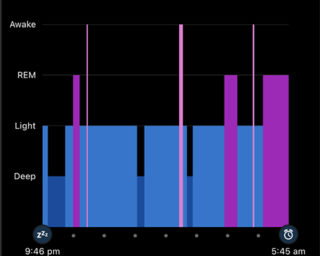I’ve spent the last couple of weeks sleeping with a Garmin watch strapped to my wrist to monitor my sleep patterns and the amount of time I spend dreaming. What have I learned?
I successfully resisted playing with sleep technology until now, but curiosity got the better of me. I thought about getting an Oura ring, as I’m a dedicated analogue watch wearer, and didn’t really want to wear two watches, but then I didn’t really want to wear an extra ring either. In the end, I bought a relatively simple Garmin watch, and wore it continuously for two weeks so that it could get to know me.
My early mornings are sacred. The closest I get to looking at my cell phone – or any technology – is switching off the alarm if I haven’t woken naturally. Then I stay in bed, allowing time to recall my dreams and bathe in their magic. I generally remain in no-tech mode during breakfast, but my Garmin has tempted me to peruse my Sleep Score and Stages Timeline while I eat my muesli.
REM (dream) sleep shows up as vivid deep pink bars on the Stages Timeline bar chart, against a background of light blue for blocks of light sleep, and dark blue for periods of deep sleep. Awake periods are depicted with pale pink.

Peek into my sleep!
It’s the vivid deep pink bars that grab my attention, a suitable colour for my vividly colourful dream life. I’ve noticed that most of my REM occurs after six hours of sleep. There may be a slim bar or two of deep pink during the night, but it’s after six hours that the big thick chunks of delicious REM show up. Although this fits in with what we know about sleep – that 60-90% of our REM happens in the last two hours of an eight-hour sleep – I’m still surprised to see the colourful reality of it painted on my phone report.
It glows, a big luminescent pink slab of late sleep delight: ‘Look what you get,’ it declares, ‘your dream reward for having a good long sleep’.
On a few mornings I have woken around 5am and contemplated getting up early to get ahead for the day, but knowing that my sleep is important, I have done my ‘get back to sleep’ breathing exercises and returned to slumber. It was intensely satisfying, on those mornings, to see the wide vivid pink bars signalling the REM – and dreams – I would have missed if I hadn’t returned to sleep.
Are these sleep tracking devices accurate?
It’s early days, but research over the past few years suggests they are about 78% accurate in measuring sleep versus awake time, and only about 38% accurate in measuring how long it takes you to fall asleep. Accuracy in detecting and measuring sleep stages (deep sleep, light sleep, REM sleep) is possibly less: research so far suggests inconsistent results.
If you want an accurate measurement of your sleep stages you need a polysomnography test which measures your brain waves, heart rate, breathing, blood oxygen levels, and eye movements by attaching electrodes to your scalp and other skin areas.
Sleep tracking devices such as my Garmin watch measure your heart rate and motion to estimate your sleep stages.
It’s been fun, and I will continue to examine my Sleep Score and Stages Timeline for a while, comparing it to how I actually feel: do I feel like I slept well, do I remember lots of dreams, do I feel refreshed and ready for my day, or do I feel tired?
Sleeping and dreaming apart, it’s been interesting to track my heart rate during exercise, and to discover my average resting heart rate (a rather low 50 or less) and my upper range fitness capabilities. But wearing two watches, one on each arm? Not so sure about that!
You might also enjoy


